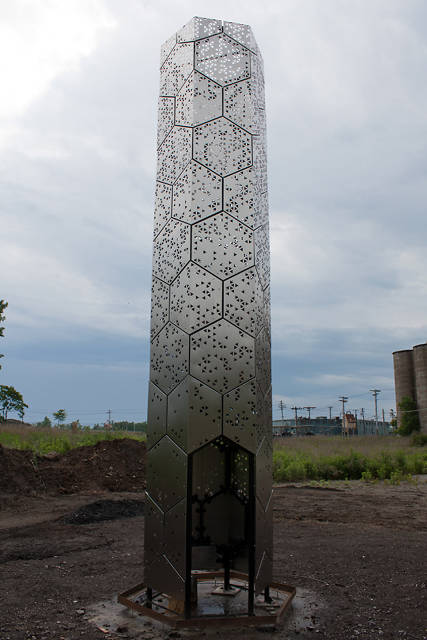Rick Smith didn't set out to save the honeybees. Instead, when the Buffalo business owner purchased a 15-acre plot of land along a bend in the Buffalo River just east of Lake Erie in 2006, he planned to build an ethanol plant there. Once part of the largest grain port in the world, the property was dotted with century-old grain elevators and towering, concrete silos that could store nearly a million bushels of corn. But when the ethanol boom went bust in 2008 amid soaring corn prices, so too did Smith's Rust-Belt revival plan.
Clik here to view.

Now Smith is revitalizing the land, known as Silo City, on a more modest scale. After finding a rogue bee hive on the second floor of a derelict office building there, Smith commissioned a competition among 10 teams of architecture students from the University at Buffalo to design a new home for the insects that would both shelter them and showcase their fragile existence. Since 2006, a mysterious phenomenon known as colony collapse disorder has drastically reduced the country's population of honeybees, which pollinate most of our fruit and vegetable crops.[/br]
Completed in June, Elevator B is a 22-foot-tall steel, cypress, and glass structure with a silhouette that mirrors the grain silos surrounding it. Bees live inside the tower in a cypress "bee cab," which can be raised and lowered on a pulley by a beekeeper. A laminated glass bottom allows visitors who step inside the 4-foot-wide hexagonal tower to glimpse the bees at work. "It's a symbol for the regeneration of the site on an environmental and economic level," says Courtney Creenan, one of the five students who designed and built the winning project.
Clik here to view.

It's also part of the growing field of "pest architecture," in which human-made structures are designed specifically to attract and preserve threatened creatures in urban spaces. In 2008, Joyce Hwang (who also served as an advisor on the Elevator B project) built a 12-foot-tall Bat Tower in a nearby sculpture park aimed at drawing attention to white-nose syndrome, which has killed millions of North American bats. And in 2010, the London-based architecture firm Arup Associates built The Insect Hotel, which won a government-backed competition to create a sustainable habitat in London parks for beetles, moths, butterflies, and spiders.[/br]
The 1,300-pound sculpture consists of a welded steel frame sheathed in 66 hexagonal, rigidized steel panels. Each panel features a unique pattern of triangular cutouts that progressively allow more light and air to enter near the top of the structure. Smith's firm, Rigidized Metals, paid for the $10,000 project and fabricated the textured steel panels that give the tower its distinctive look. The 5-foot-tall bee cab features 2-inch-thick cypress walls that insulate the bees during Buffalo's brutal winters. Bees enter and exit the cab through three small holes drilled into the side of the cab.[/br]
Local beekeeper Phillip Barr orchestrated the 9-hour-long process of extracting the bees from their squatter home and moving them to their fancy new digs in early June. An estimated 25,000 bees had wedged themselves into a two-inch gap between a double-paned glass window and a plywood board covering the window frame from the outside. Barr used a hammer to break off small pieces of the glass, and then gently sucked the bees from the honeycomb with a vacuum. "It's a hairy process," says Barr. "If you go too fast, the bees will take flight on you." Luckily, that didn't happen. Once Barr dumped the colony, including the queen, into the cypress cab, the worker bees went right to work building a new wax comb.[/br]
Student groups have already begun touring Elevator B to learn about the hive, the importance of bees to our food supply, and the historic role of Silo City in distributing grain along the eastern seaboard for most of the 20th century. Smith says he hopes to use the rest of the property as a nonprofit arts center and to house several for-profit building-materials makers. "The regeneration of the site is important for getting innovation back to the region. We don't want it to be a museum. We want it to be active," says Smith. The monumental new beehive should certainly help to build buzz.